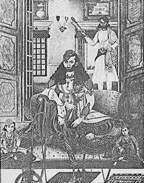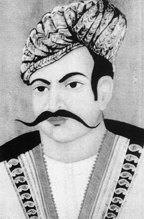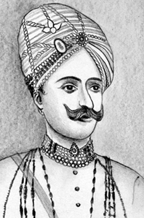 People's Democracy
People's Democracy
(Weekly
Organ of the Communist Party of India (Marxist)
No. 21
May 27, 2007
(Weekly
Organ of the Communist Party of India (Marxist)
|
Vol.
XXXI
No. 21 May 27, 2007 |
Role of Punjab, Haryana And Himachal Pradesh
In 1857: Myth and Reality

Abdul Rahman Khan, Nawab of Jhajjar
Executed on the 23rd December 1857 for treason and rebellion against the British Govt
K C Yadav
A GENERAL notion persists that Punjab (i.e., east and west Punjab, including Haryana and parts of Himachal Pradesh) was loyal to the British in the stormy days of 1857. The Punjabis, especially both the ‘dominant’ communities, the Sikhs and Muslims, it is believed, helped the British with men, money and material during the Revolt. The usual argument made for this attitude of the Punjabis is that after the annexation of Punjab (1849), John Lawrence (who became chief commissioner of the province) and his band of dedicated and dynamic officers had not only turned the badly disturbed Land of the Five Rivers into the best governed British Indian province from 1849 to 1857, but had also given to its people peace, prosperity and happiness — something which they had not seen in their long history. Consequently, the ‘grateful’ Punjabis stood by their benevolent rulers and thereby saved the British empire.
This is absolutely untrue! John Lawrence’s rule was the worst thing that could have happened to Punjab. Its main aim was, in Lord Dalhousie’s words, “to kill the spirit of the Khalsa”, and “isolate the Muslims from the worlds beyond the Indus and the Sutlej”. They had put a girdle of troops around the Majha, the home of the Sikh soldiery, under their two best generals. And they had done almost some similar intizam in the northwestern region, too, where there was a preponderance of the turbulent Muslim tribes. In all, 45 per cent of the entire Bengal army and 60 per cent of its European troops were deployed and kept in a stand-to position in Punjab. In Bengal and the North-Western Provinces there was one sepoy over the heads of five thousand persons, but in Punjab there was one sepoy over the heads of 120 persons. There was a terribly tight bureaucratic grip over the people: “The authorities had made full preparations to meet any emergency in the province in 1857”. Still Punjab was afire, though in varying degrees.
There were serious sepoy mutinies at Ferozepur, Hote Mardan, Jullundur, Phillaur, Jhelum, Sialkot, Thanesar, Ambala, Lahore, Peshawar and Mianwali. Some people underestimate these risings and negate the role of the Punjabis, dismissing these uprisings as the doings of Purbias (i.e., the Purbia soldiers of the Bengal army). This is incorrect: the regiments, which played a heroic role in these mutinies, were the ‘mixed’ ones. They consisted of Hindus (of high and low castes), Muslims, Sikhs, Purbias and Punjabis. All of them stood together. They fought together. They died together. For one cause — ousting the firangi from their country.
There is another very significant feature of these mutinies that has not been highlighted. Nowhere in Punjab did the sepoys rebel without the tacit understanding and positive support of the local civilian population. Aberrationally, if they rose on their own anywhere, they did not succeed in their mission. Ambala is a good example to prove the point. About nine hours before the outbreak at Meerut (10 May), the 5 NI, 60 NI and 4 LC regiments stationed at Ambala revolted. They attacked their regimental kotes, seized arms, and arrested their officers. They had no liaison with the civilian population in the city. Their rebellion failed. On the other hand, the sepoys at Jullundur, Ludhiana, Ferozepur, Sialkot, etc., had established contact with the local inhabitants of the respective areas. It became possible for them to carry on their struggle with widespread local support. We can see this phenomenon working even outside Punjab. The failure of the mutiny at Barrackpore, and its resounding success at Meerut, for instance, can be explained only in the light of this factor.
The Revolt was, at least in Punjab, everybody’s concern. Barring a few ruling princes and their hangers-on, the people belonging to different religions, castes, and classes had an interest – a positive interest to be precise – in it. The poorer sections of the people, the illiterate, and the lower castes were a part of the struggle. “The lower orders and castes among the Hindus and Mohammedans” at this place, remarked the deputy commissioner of Ludhiana, “followed any casual leader that turned up and joined in promoting general disorder”. According to the deputy commissioner of Sialkot, at his station “the menial servants were very generally implicated (in the Revolt)”. At some places where anti-firangi feeling was universally strong and deep, even such sections of the population who derived personal benefits from the British, and who were in their hearts, for this reason, on the side of the British, were not prepared to back their masters openly. They were penalised later by their colonial masters for betraying their salt (namak-harami).
As for the Sikhs, their supposed loyalty to the British is a myth. They played an outstanding part in the uprising. “It is a curious fact”, says T D Forsyth, deputy commissioner of Ambala, “that the first man, not a soldier, in the Punjab – and I say in all upper India – who was hanged for sedition was a Sikh”. Forsyth was referring to Sardar Mohar Singh of Rupar (Ambala) who led an uprising in the area. Mohar Singh openly supported Bahadur Shah Zafar, going as far as declaring a Khalsa-Mughal Raj in Rupar. Also the first village to have suffered the punishment of ‘burning’ in the province was the village of Dabri in the state of Nabha. The residents of Dabri were predominantly Sikhs They collectively became victims of British terror for having helped a ‘grand rebel’, a Hindu faqir named Shamdas. In the cities too the Sikhs did not lag behind others in fighting their enemy. In Ludhiana, according to the deputy commissioner of the district, “almost every class had its representatives on the gallows”. The Sikhs were also there, he says, for their men had taken part in the rising.
It is a fact of history that the Sikh sepoys stood by their comrades in the regiments that rebelled within and outside Punjab. F B Gibbon, a major authority on the subject and author of The Lawrences of the Punjab (1908), explodes the whole myth of Sikh loyalty very forcefully: “The part played by the Sikhs during the Mutiny crisis, has been largely misunderstood, and far too much credit has been given to them for an enthusiastic loyalty that was never theirs, owing to the practice of calling all Punjabis indiscriminately as Sikhs — a short and easy but misleading term”. The protected Sikh chiefs were “gloriously loyal throughout” but not the Sikhs as a community. According to Gen. McLeod Innes, “One often reads loosely worded allusions to John Lawrence having sent down large bodies of newly raised Sikhs to Delhi. In point of fact, he sent none”. The British authorities tried to bribe “the spirited Sikhs to come to their side”, but to no avail. A disheartened Nicholson wrote to John Lawrence on August 27, “We have been trying to get Sikhs without success”. Thus, barring the chiefs of Patiala, Nabha, Jind, etc. Sikh masses were not loyal to the British.
In the northwestern areas of Punjab there were unprecedented popular risings led by Muslims. Hundreds of people rose up in open revolts in the whole region. The biggest and fiercest of these revolts took place in district Gogira, in the Neelibar region, around Sahiwal, where tribe after tribe, village after village, people after people rose up to oust the firangi from their land. In John Lawrence’s estimate the rebels numbered 1,25,000. Surprisingly they were fighting for Bahadur Shah even after the fall of Delhi.
The British crushed the movement in Punjab with a heavy hand. Thousands of persons were hanged, or blown from guns, without any trial or formal investigation. Several towns were plundered and villages destroyed. Frederic Cooper, the deputy commissioner of Amritsar, ordered the killing of hundreds of rebels at Ajnala. Their bodies were thrown in a well, Kalyan-da-khuh, which still exists. The Ajanala ‘black-hole’ episode remains one of the blackest spots in the history of British rule in India.
HARYANA

Rao Tula Ram of Rewari
In Haryana the uprising was still fiercer. The region was, materially speaking, very backward. Because of the loot and plunder of the colonial rulers it had to face frequent famines which led to the death of countless people and cattle year after year. Not surprisingly, there was widespread discontent against the British in Haryana.
The news of the outbreak of the uprising at Meerut and Delhi was greeted with joy in every nook and corner of the state. The districts of Gurgaon, Rohtak, Hissar, Panipat, Thanesar and Ambala came under the influence of the rebels in no time. The people, cutting across religious affiliations and belonging to all classes, came forward in large numbers to put an end to the oppressive firangi raj once and for all. So strong was the popular indignation against foreign rule in the region that unlike their Punjab counterparts, all the local chiefs of Haryana – the chiefs of Jhajjar, Farrukhnagar, Bahadurgarh, Dujana, Ballabhgarh, etc. – elected to side with the rebels.
The people of Haryana were lucky to have found some really good leaders of stature and substance such as Sadruddin Mewati in Mewat, Rao Tula Ram in Rewari, Mohammad Azim in Hissar, Gen. Abdus Samad Khan in Jhajjar, Nawab Samad Khan in Sirsa, Ramo Jat in Karnal, and Imam Qalandari in Panipat. The peasant, the worker, the poor and the rich all fought bravely under these leaders and kept their land free until the fall of Delhi (September 20, 1857).
After recapturing Delhi, the British sent their most experienced commanders to bring Haryana “under their control”. Gen. Van Courtland, Brig.-Gen. Showers, Col. Gerrard, Capt. Drummund, etc. launched heavy attacks from all sides. The brave Haryanavis fought desperately even in those very dismal days. In the battles of Narnaul, Ballah (Panipat) and Mewat, fought as late as November 1857, they showed their true mettle. Their defeat was, for obvious reasons, a foregone conclusion but it is really a creditable thing that even the victors praised their bravery and devotion to the cause they were fighting for.
The British let loose an unprecedented reign of terror in Haryana. They killed thousands of people and destroyed property worth many crores of rupees. They burnt over eighty villages — sixty in the Mewat region alone.
HIMACHAL PRADESH

Rao Gopal Dev
British rule had meant unimaginable humiliation and oppression for the people of Himachal Pradesh. In the words of Gen. Napier: “We force the Indian to work at plough and we force him to walk thousands of miles carrying the luggage of the English soldiery. The Indian peasant loses his harvest, his land remains uncultivated and his family perishes, his oxen overworked by the soldiers, fall on the way and he does not receive a farthing as compensation for this. His broken plough is left on the way and he is dragged to shoulder another plough whose master has fled away in desperateness. And after six or eight months the peasant is sent back ruined to his house where he used to live happily and peacefully before our arrival there. There he may find his wife and children; but if the wife is beautiful, he will hear that the European magistrate has taken her for himself. I am told that these magistrates have no scruples about taking the Indian women. (emphasis added).
This is just one grievance. There were many more such grievances. As a result, the Himachalis were very unpahhpy with the British raj. They wanted to get rid of it somehow or the other. But their task was difficult. They had no leaders. They suffered from the inadequacy of the material means necessary to wage a war effectively. They had no formidable army. No sufficient fire-arms and ammunition. Not even sufficient rations with which to sustain themselves and fight for a long time.
It must, however, be said to their credit that despite all these problems and inadequacies the hill people fought against the colonial enemy. They made the best possible use of whatever was available with them — their courage, their wisdom, and so forth. They used, for instance, rumour as a strategy, and an effective weapon in their struggle. This worked very well. For instance with a small rumour that the governor-general had asked the authorities to send human flesh, they got hundreds of hapless forced labourers and domestic servants working in British homes freed. This hurt the sahibs at their weakest spot. However, at a number of places, people made a positive effort to rise in open revolt. Raja Pratap Singh of Kula, Ram Prasad Bairagi, Raja Pratap Chand of Teerah, and the Rani of Jutog are some of those brave leaders. Some others tried to follow them. But the alert British officials barred their way almost everywhere. In most of the cases they lost the struggle even before these commenced. But successful or unsuccessful, they joined the struggle against colonial rule bravely despite heavy hurdles and a formidable enemy.
In this 150th year of the uprising, it seems appropriate that the truth about the courageous people of India in the great war of their freedom lying buried under the debris of falsehood be extricated, and presented in colours true to history.